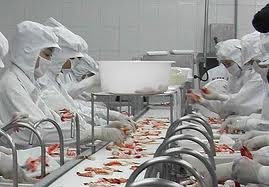Exporters looking for fresh air
 Head of Central Institute for Economic Management’s (CIEM) Business Environment Department Nguyen Thi Tue Anh said Vietnamese export companies were weak in diversifying product ranges and export markets and reported low business efficiency, leveraged on Vietnam’s competitive advantages such as low-cost labour, bountiful natural resources and state incentive policies.
Head of Central Institute for Economic Management’s (CIEM) Business Environment Department Nguyen Thi Tue Anh said Vietnamese export companies were weak in diversifying product ranges and export markets and reported low business efficiency, leveraged on Vietnam’s competitive advantages such as low-cost labour, bountiful natural resources and state incentive policies.
“The country’s three key export items- textiles and garments, seafood and electronic items- feature low added value,” Anh said when announcing Vietnam exporters’ competitive capacity report in a ceremony hosted by CIEM in Hanoi on April 19.
A lack of capital and leading edge technologies, dearth of skilled labour, heavy reliance on imported materials and equipment have undermined Vietnamese exporters’ competitive advantages.
“Businesses failed to turn out products with high added value due to lack of capital and technologies. This has diminished their revenue and profits and made them hard to retain their market shares,” Anh said.
She said Vietnam’s current export processing model was a key factor that had diluted Vietnamese exporters’ competitive advantages.
Reality shows that the export processing model was commonplace in the textile and garment sector. Around 60 per cent of textile and garment businesses directly involving in export production and 70 per cent of businesses producing export items under outsourcing contracts that joined CIEM surveys had to import materials.
The sector’s current advantages were built on low-cost workforce and state export supportive policies, according to a CIEM study.
Electronic export firms are in the same position as they are also heavily reliant on imported materials and components.
There exists a big contrast among businesses active in Vietnam’s electronic items production, said Nguyen Minh Thao, from CIEM’s Business Environment Department.
Meanwhile, foreign-invested firms are strong in capital and technology, local firms always incur big capital-related pressures and employ less-than-modern technology.
Unlike textile, garment and electronic businesses, seafood exporters have their own advantages, said Luu Minh Duc also from CIEM’s Business Environment Department.
“Many seafood export firms follow well-planned business strategies. They use modern and extensive technological processes and apply advanced management models,” Duc said.
Duc, however, said that lack of capital and production space, and cumbersome tax and customs procedures have eroded seafood exporters’ competitive advantages.
In respect to how to enhance Vietnamese exporters’ competitiveness, Anh said the government needed to help businesses deal with short term difficulties and work on measures to sharpen competitiveness in the long term such as assisting them with lowering the production costs and launching new products with higher added values.
“Big seafood exporters such as Minh Phu or Hung Vuong needed to take bold steps such as buying out foreign importers or producers to acquire their brands and take advantages of their local distribution systems,” Duc said.
What the stars mean:
★ Poor ★ ★ Promising ★★★ Good ★★★★ Very good ★★★★★ Exceptional
Related Contents
Latest News
More News
- Global partnerships key to Vietnam’s IFC development (December 26, 2025 | 16:18)
- Vingroup pulls out of bid to invest in North-South high-speed railway (December 26, 2025 | 11:42)
- Strengthening supply chains through trade promotions and customs reform (December 24, 2025 | 14:00)
- PM orders investment model for North–South high-speed rail (December 22, 2025 | 17:43)
- LS Eco Energy to invest in Vietnam rare earth sector (December 22, 2025 | 17:31)
- Government moves to establish International Financial Centre (December 21, 2025 | 21:00)
- Vietnam's IFC to target global investment flows (December 21, 2025 | 18:00)
- Two national hospitals expand capacity with new facilities (December 20, 2025 | 09:00)
- Ha Tinh breaks ground on major Vingroup industrial and energy projects (December 19, 2025 | 18:24)
- EVN launches major power infrastructure projects nationwide (December 19, 2025 | 18:17)

 Tag:
Tag:





















 Mobile Version
Mobile Version